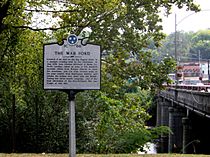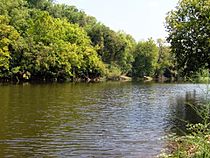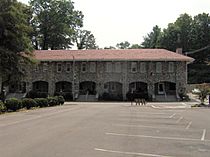Newport, Tennessee facts for kids
Quick facts for kids
Newport, Tennessee
|
||
|---|---|---|
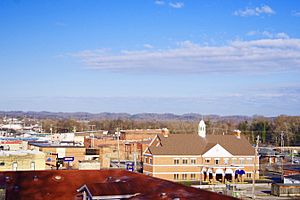
Downtown Newport
|
||
|
||

Location of Newport in Cocke County, Tennessee.
|
||
| Country | United States | |
| State | Tennessee | |
| County | Cocke | |
| Founded | 1799 | |
| Incorporated | 1867 | |
| Government
v
|
||
| • Type | Mayor-council | |
| Area | ||
| • City | 5.53 sq mi (14.33 km2) | |
| • Land | 5.53 sq mi (14.33 km2) | |
| • Water | 0.00 sq mi (0.00 km2) | |
| Elevation | 1,168 ft (356 m) | |
| Population
(2020)
|
||
| • City | 6,868 | |
| • Density | 1,241.28/sq mi (479.25/km2) | |
| • Urban | 11,293 | |
| Time zone | UTC-5 (Eastern (EST)) | |
| • Summer (DST) | UTC-4 (EDT) | |
| ZIP codes |
37821-37822
|
|
| Area code(s) | 423 | |
| FIPS code | 47-53000 | |
| GNIS feature ID | 2404374 | |
Newport is a city in and the county seat of Cocke County, Tennessee, United States. The population was 6,945 at the 2010 census, down from 7,242 at the 2000 census. The estimated population in 2018 was 6,801. Newport is located along the Pigeon River.
Contents
History
Early settlement
The Great Indian Warpath passed through what is now Newport en route to the ancient Cherokee hunting grounds of northeastern Tennessee. The Warpath crossed the Pigeon River at a point approximately 0.2 miles (0.3 km) east of the McSween Memorial Bridge (US-321), in an area where the river is normally low enough to walk across. The first European traders to the area, arriving in the mid-18th century, called this point along the Pigeon River the "War Ford".
During the American Revolution, the Cherokee aligned themselves with the British, and launched sporadic attacks against early Euro-American settlers in the Holston valley. In the waning months of the conflict in 1782, a detachment led by Gen. Charles McDowell of North Carolina crossed the mountains into what is now Tennessee to join up with Col. John Sevier's local forces and initiate an aggressive campaign against the hostile Cherokee. In August of that year, Sevier crossed the Pigeon at War Ford, attacking and killing several Cherokee camped along the river's banks. This assault was one of the final engagements of the Revolution.
At the close of the Revolution, the first Euro-American settlers arrived in the Newport area, ensconcing themselves in the vicinity of the strategic river fords. Peter Fine established a ferry on the north bank of the French Broad in the early 1780s, and in 1783 John Gilliland settled opposite Fine's Ferry in what is now Oldtown. Shortly thereafter, Emanuel Sandusky, a Polish immigrant, established a farm on the land where the Cocke County Memorial Building now stands, and Samuel O'Dell settled at the junction of the Pigeon River and Cosby Creek. Sometime in the 1790s, the Gilliland family donated 50 acres (200,000 m2) of land for a town square and courthouse to be situated opposite Fine's Ferry on the banks of the French Broad, and the town of New Port was born.
For nearly a quarter-century, the residents of the Newport area lived under constant threat of attack from Cherokee crossing the mountains from North Carolina. Shortly after the arrival of the first Euro-American settlers, Peter Fine sought to quell this threat by leading a punitive expedition against the Cherokee town of Cowee in North Carolina, which Fine captured and burned. The Cherokee responded by stealing Fine's livestock and attempting to herd them back to North Carolina. Fine gave chase and managed to retrieve the livestock, but on the return march he was ambushed and his brother, Vinet, was killed. The Cherokee were in pursuit, and Vinet's body was hidden in a hole in a frozen creek for later retrieval. The creek melted and the body was lost. The creek was named Fines Creek. Shortly thereafter, two O'Dells were killed, one of Sandusky's daughters was kidnapped, and several others settlers were killed.
To provide defense against these sporadic attacks, the early settlers erected a series of forts in the area. Wood's Fort guarded the Forks-of-the-River just downstream from Newport, and McCoy's Fort and Whitson's Fort defended the area to the south. Other installations included Huff's Fort at what is now Del Rio. With Sevier's victory at the Battle of Boyds Creek and the ensuing Treaty of Dumplin in 1785, Cherokee influence in the area began to wane. In the 1790s, the Cherokee signed a series of treaties which essentially ceded most of the land on the Tennessee side of the Great Smokies to the U.S. government. By 1800, Cherokee attacks in the Newport area had been drastically reduced.
Flatboat period
The French Broad River passes 1 mile (1.6 km) north of the current city limits. As the French Broad empties into the Tennessee River, towns along its banks are connected via waterway to New Orleans and the Gulf of Mexico. In the early 19th century, William Faubion, who lived just northeast of New Port, managed to reach New Orleans with a flatboat shipment and return safely. In early 19th-century East Tennessee, which was riddled with poor roads and hilly terrain, river travel was a relatively convenient mode of transportation. "New Port", situated on the French Broad near Forks-of-the-River, quickly developed into a flatboat trading hub.
William Garrett (1774–1853) arrived in New Port in the late 1790s and built a plantation, known as Beechwood Hall, just south of Fine's Ferry. Many early travelers, including several circuit riders and religious leaders, were entertained at Garrett's mansion. During the War of 1812, Garrett shipped eight large flatboats stocked with food and whiskey to the U.S. Navy in New Orleans.
Among those entertained at Beechwood Hall in the early 19th century was Bishop Francis Asbury, a circuit rider credited with spreading Methodism to the Southern Appalachian region.
In 1812, a large Methodist revival was held at New Port's crude log courthouse, and the Zion Methodist Church was established that same year. The Presbyterians erected a church on Graveyard Hill (above the modern junction of US-321 and US-70) in the 1820s. The residents of New Port established one of the first schools in the area, Anderson Academy, in 1820. New Port was officially incorporated on October 19, 1812.
While New Port had strong religious beginnings, its situation as a river trading hub on the edge of the Appalachian frontier inevitably led to a certain lawlessness.
New Port's residents countered this lawlessness with swift methods of justice. The town had a pillory, stocks, and a ducking chair. Hangings were not uncommon.
Civil War
By 1834, New Port had a population of 150. The town included two general stores, two doctors, three blacksmiths, two tailors, two hatters, a wagon maker, two churches, and two taverns. A new brick courthouse had been erected in 1828 to replace the crude log courthouse.
While slavery was not as common in East Tennessee as in other parts of the Southern United States, it did occur. Some buildings in early Cocke County were built with slave labor.
When the Civil War broke out in the 1860s, New Port attempted to remain neutral. The town was a consistent target of raids from both Union and Confederate soldiers. The owners of Beechwood Hall buried their silver and kept their horses in the basement to prevent them from being stolen. The residents of Cocke County eventually recruited a home guard to protect them from raids, which they based at the mouth of Indian Camp Creek, a few miles south of New Port.
Several skirmishes occurred in the vicinity of New Port, namely along Lick Creek to the north and Cosby Creek to the south. At the latter, the brother of North Carolina Governor Zebulon Vance was captured in an ambush.
Alexander Arthur and the logging boom
Innovations in the logging industry in the late 19th century led to a rapid deforestation of the Ohio Valley and Mississippi Delta. Logging companies eventually turned to the timber-rich forests of Southern Appalachia to keep up with the increasing demand for wood, and band saw mills began spring up in towns located along the base of the mountains.
In 1880, Canadian-born entrepreneur Alexander Arthur (1846–1912), representing the Scottish Carolina Timber and Land Company, arrived in Newport with ambitious plans to log the Pigeon valley. Arthur's plan called for the construction of a series of dams and booms which would be used to move logs from the higher elevations downstream using the river's current. The logs would eventually be floated all the way to Knoxville. The operation would be based in Newport, with a sawmill in the higher elevations at Pigeon Valley (now Hartford, Tennessee).
Over the next six years, Arthur and his team of engineers and lumberjacks—some from as far away as South Africa and Europe—cut and sawed thousands of logs which they stocked behind a large dam. Arthur built an extravagant house in Newport and even made proposals to modernize the town square.
The residents of Newport—who were nonplussed by the flashy and energetic Arthur—warned the entrepreneur about the Pigeon River's volatility. While the mountain streams of Southern Appalachia appear calm and serene on a typical day, torrential rains in the higher elevations can turn these streams into raging whitewater rapids. In the spring of 1886, the warnings of the locals became reality when a cloudburst hit the Balsam Mountains near the Pigeon's source and the river became a raging torrent. All day long, Arthur and his team fought ferociously to secure the dam holding back the company's precious stock of logs. That evening, one of Arthur's engineers returned to Newport briefly to rest. Before leaving again, he told the anxious wives of the company men and the curious Newportians that if they heard the whistle, all would be "gone to hell".
His venture now bankrupt, Alexander moved to Knoxville to start rebuilding his fortune. He would later be instrumental in the founding of Middlesboro, Kentucky. The residents of Newport converted Scottish Timber's now-abandoned commissary into a saloon.
1900s
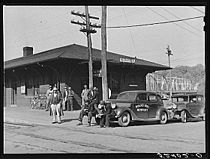
By the 1890s, the population of Newport had grown to 900. While Alexander Arthur's logging venture failed, industry continued to find its way to the town. In 1895, the A.C. Lawrence Leather Company established what eventually become one of the world's largest tanneries in Newport. Three years later, brothers James and John Stokely founded the Stokely Brothers Company (now Stokely-Van Camp's) to can vegetables they grew throughout the French Broad valley. Newport native Ben Hooper served as governor of Tennessee from 1911 to 1915.
Carson Springs, 6 miles (10 km) southwest of Newport, developed around William Wilson's tavern and stagecoach terminal in the early 19th century. Later in the century, C.P. Peterson and wife built and operated the Peterson Hotel. As the mineral-rich mountain springs of Appalachia were thought to have health-restoring qualities, Carson Springs developed into an early tourist resort. The establishment of the Great Smoky Mountains National Park in 1934 brought a still greater influx of tourists to Newport, but nothing like the tourism explosion that occurred in neighboring Sevier County.
Kiffin Yates Rockwell, who was born in Newport in 1892, joined the French Foreign Legion during World War I. After being wounded, Rockwell joined one of the Legion's aviation corps, known as the Lafayette Escadrille, and would become the first American pilot to shoot down an enemy plane in combat.
Geography
Newport is located in western Cocke County at 35°57′48″N 83°11′48″W / 35.96333°N 83.19667°W(35.963318, -83.196542). The town is situated along the Pigeon River in an area where the foothills of the Great Smoky Mountains descend into the French Broad drainage basins. English Mountain rises prominently to the southwest and Hall Top Mountain rises to the southeast, with the Pigeon River cutting a valley between the two. The Great Smoky Mountains National Park boundary passes some 15 miles (24 km) to the south.
The confluence of the French Broad, Nolichucky, and Pigeon rivers occurs 10 miles (16 km) northwest of Newport in an area once known as Forks-of-the-River. This area now comprises the northeastern section of Douglas Lake, which was created by an impoundment of the French Broad by the Tennessee Valley Authority in the 1940s. The French Broad eventually merges with the Holston River in Knoxville to form the Tennessee River, some 40 miles (64 km) to the west of Newport.

Several major federal highways intersect at Newport. Interstate 40 passes through the city's southern section about 18 miles (29 km) north of the North Carolina border. U.S. Route 321 runs perpendicular to I-40, approaching Newport from Cosby to the south. U.S. Route 411 merges with U.S. Route 70 in Carson Springs, and the merged road enters Newport from the west, intersecting US-321 in downtown Newport. US-70 continues east to Del Rio, Tennessee, and Hot Springs, North Carolina, while US-321 turns north and crosses the Pigeon and French Broad en route to Greeneville and northeastern Tennessee.
Newport consists of several sections relating to its historical development. The main section of town, centered around the courthouse, is situated along the south bank of the Pigeon amongst a series of relatively low but steep cliffs. North of the main section is "Oldtown", situated between the Pigeon and French Broad, which was the town's main area before the advent of the railroad in the late 19th century. A more modern section of town has developed along US-321 between the courthouse area and I-40.
According to the United States Census Bureau, the city has a total area of 14.3 square kilometres (5.5 sq mi), all of it land.
Demographics
| Historical population | |||
|---|---|---|---|
| Census | Pop. | %± | |
| 1870 | 281 | — | |
| 1880 | 347 | 23.5% | |
| 1890 | 658 | 89.6% | |
| 1900 | 1,630 | 147.7% | |
| 1910 | 2,003 | 22.9% | |
| 1920 | 2,753 | 37.4% | |
| 1930 | 2,989 | 8.6% | |
| 1940 | 3,575 | 19.6% | |
| 1950 | 3,892 | 8.9% | |
| 1960 | 6,448 | 65.7% | |
| 1970 | 7,328 | 13.6% | |
| 1980 | 7,580 | 3.4% | |
| 1990 | 7,123 | −6.0% | |
| 2000 | 7,242 | 1.7% | |
| 2010 | 6,945 | −4.1% | |
| 2020 | 6,868 | −1.1% | |
| Sources: | |||
2020 census
| Race | Number | Percentage |
|---|---|---|
| White (non-Hispanic) | 5,987 | 87.17% |
| Black or African American (non-Hispanic) | 267 | 3.89% |
| Native American | 19 | 0.28% |
| Asian | 46 | 0.67% |
| Pacific Islander | 2 | 0.03% |
| Other/Mixed | 326 | 4.75% |
| Hispanic or Latino | 221 | 3.22% |
As of the 2020 United States census, there were 6,868 people, 2,776 households, and 1,692 families residing in the city.
Education
Schools located in Newport: The City of Newport manages Newport Grammar School.
Cocke County Board of Education manages Cocke County High School, Cosby High School, Cosby Elementary School, Northwest Elementary School, Smokey Mountain Elementary School, Parrottsville Elementary School, Del Rio Elementary School, Grassy Fork Elementary School, Bridgeport Elementary School and Edgemont Elementary School.
Sports
Newport was home to the Newport Canners Minor League Baseball team that played in the Class D Appalachian League from 1937 to 1942 and the Mountain States League from 1948 to 1950.
Historic structures in the Newport area
- Beechwood Hall, constructed in 1803 and placed on the National Register of Historic Places in 1975
- O'Dell House, constructed in 1814 and placed on the NRHP in 1975
- Cocke County Courthouse, constructed in 1930 and placed on the NRHP in 1995
- Elm Hill, constructed in the 1890s and placed on the NRHP in 1975
- Rhea-Mims Hotel, constructed in 1925 and placed on the NRHP in 1998. In 2000, the hotel was refurnished as a home for senior citizens by the firm Barge, Waggoner, Sumner, and Cannon, Inc.
- Cocke County Memorial Building, constructed in 1931 and placed on the NRHP in 1997
- Newport Lodge #234 F&AM Masonic Lodge constructed in 1875 by Charles Anthony Lovett of Greene County, Tennessee; served as town's first school, Newport Academy. Still stands on a hill overlooking the town on Mims Ave. and has been in continuous use as a Masonic Hall since 1898 until today.
Notable people
- Jake Crum (born 1991), NASCAR driver
- Wilma Dykeman (1920–2006), author and local historian
- Houston Fancher (born 1966), Charlotte 49ers men's basketball head coach
- Ben W. Hooper (1870–1957), governor of Tennessee, 1911–1915
- L. D. Ottinger (born 1938), NASCAR driver
- Jimmy Owens (born 1972), dirt late model driver
- James Henry Randolph (1825–1900), U.S. congressman
- Kiffin Yates Rockwell (1892–1916), World War I pilot
- Pop-Boy Smith (1892–1924), baseball pitcher
- Marshall Teague (born 1953), actor
See also
 In Spanish: Newport (Tennessee) para niños
In Spanish: Newport (Tennessee) para niños



